Launching an online business provides immediate access to Amazon’s top-tier logistics, customer service, and Prime delivery speeds. This seamless integration with a global fulfilment network is the key benefit of using Amazon FBA (Fulfilment by Amazon), a service widely trusted by Amazon sellers.
As of early 2025, approximately 82% of Amazon sellers utilise FBA, according to Helium 10. This widespread adoption underscores the efficiency and reliability that FBA brings to businesses worldwide.
In this article, we’ll explore how Amazon FBA works and why it’s rapidly becoming a leading fulfilment solution. We’ll also provide a comprehensive guide to help you get started and integrate FBA effectively into your logistics strategy.
What is Amazon FBA?
Fulfilment by Amazon (FBA) is a program that enables sellers to send their inventory to Amazon’s fulfilment centres. Amazon then stores the products, picks, packs, ships orders to customers, and handles returns and customer service.
Sellers benefit from Amazon’s world-class logistics, fast shipping (including Prime eligibility), and trusted customer support, all at a fee.
How does FBA fit into the E-commerce Ecosystem?
Amazon FBA is a crucial component of modern e-commerce, connecting small sellers with global customers. By utilising Amazon’s infrastructure, sellers can provide fast and reliable shipping, as well as access millions of shoppers worldwide.
FBA also integrates with Amazon’s marketing tools and analytics, making it easier to compete with larger brands and streamline operations.
Who Should Consider Using Amazon FBA?
Amazon FBA is ideal for the following sellers:
- Entrepreneurs seeking to scale quickly without investing in their warehousing or logistics.
- Brands that want to reach Amazon’s massive customer base and offer Prime shipping.
- International sellers who want to access new markets without local infrastructure.
- Anyone looking to automate fulfilment and focus on product innovation, marketing, or brand building.
Now that you understand what Amazon FBA is, let’s break down its benefits.
Benefits of Amazon FBA
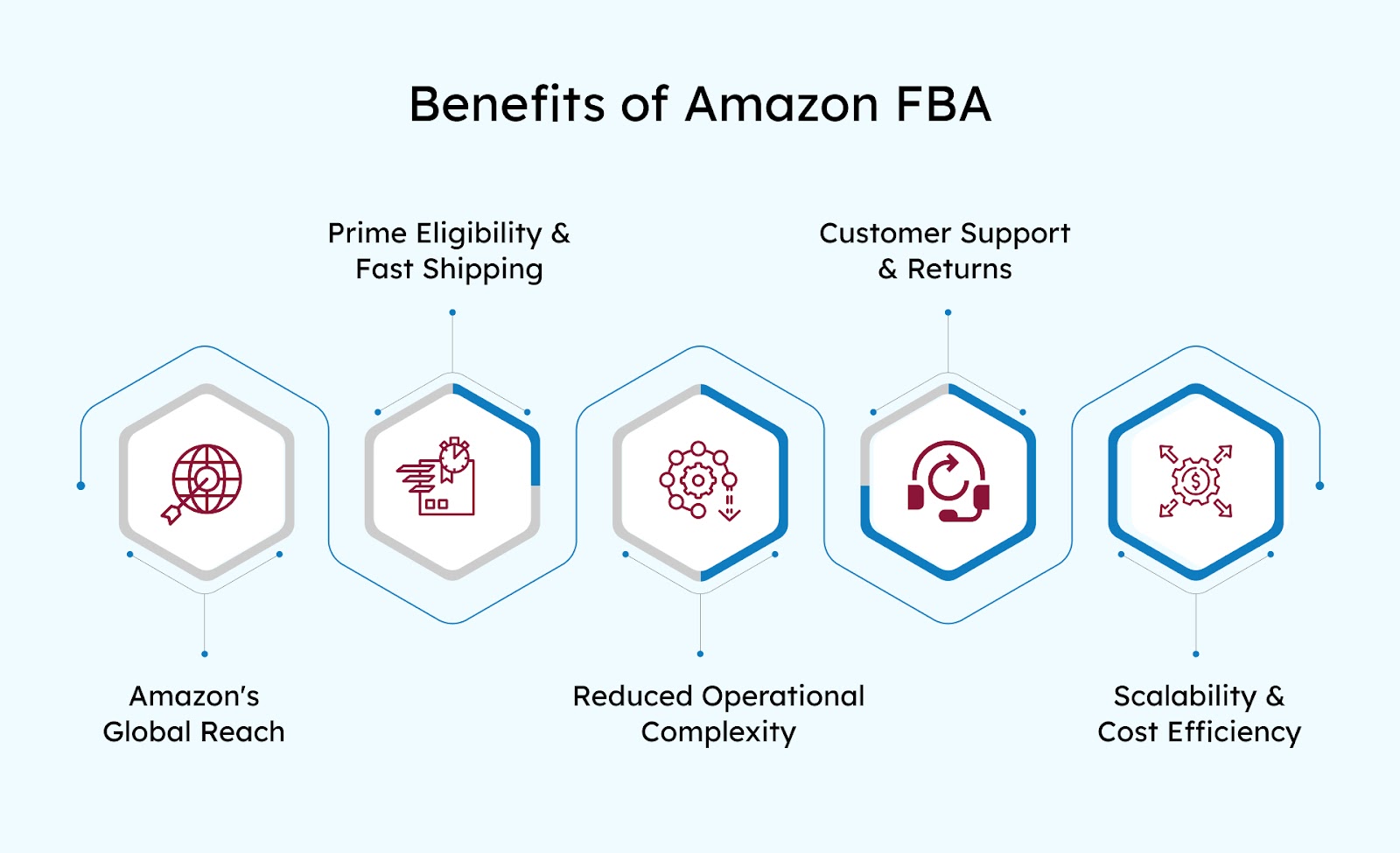
Amazon FBA handles warehousing, packing, and shipping, letting sellers focus on growth. It provides access to Amazon’s global customer base and Prime shipping while automating key operations.
FBA enables businesses to scale quickly without requiring additional infrastructure or staff. Here are the key benefits of using FBA:
1. Access to Amazon’s Global Customer Base
Using Amazon FBA opens the door to millions of potential customers worldwide. By selling through Amazon’s platform, your products gain exposure to a vast and diverse audience, which greatly boosts visibility and increases sales opportunities.
This access eliminates the need for heavy investment in marketing or other customer acquisition strategies, as you can rely on Amazon's established marketplace to attract buyers.
2. Prime Eligibility and Fast Shipping
Products stored with FBA are automatically eligible for Amazon Prime, making them accessible to millions of loyal Prime members who expect fast and reliable shipping. This not only improves the customer experience but also increases your product’s chances of being purchased, as many buyers prefer products with the Prime shipping option.
3. Reduced Operational Complexity
With Amazon FBA, Amazon handles the complexities of warehousing, picking, packing, and shipping, significantly simplifying your logistics and operational tasks. This frees up your team to focus on core business growth, such as sourcing new products, marketing, and brand building.
4. Customer Service and Returns Management
Amazon takes on the responsibility of handling customer service and returns for your FBA products. From answering customer inquiries to managing order status, Amazon's support team provides round-the-clock assistance.
Additionally, they manage returns, which is often a time-consuming process for sellers. By entrusting Amazon with these tasks, you save valuable time and ensure that your customers receive the high level of service they expect.
5. Scalability and Cost Efficiency
FBA enables you to scale your business quickly and efficiently, eliminating the need for significant upfront investments in physical infrastructure. Amazon provides storage space, shipping, and customer support, enabling you to expand your product range and reach more markets.
You only pay for what you use, whether it's storage or shipping, which makes it a cost-effective solution. This flexibility enables you to grow your business at your own pace while maintaining control over operational costs.
With these key benefits in mind, let’s explore the step-by-step process of how Amazon FBA works and how you can get started.
How Amazon FBA Works: A Step-by-Step Process to Getting Started
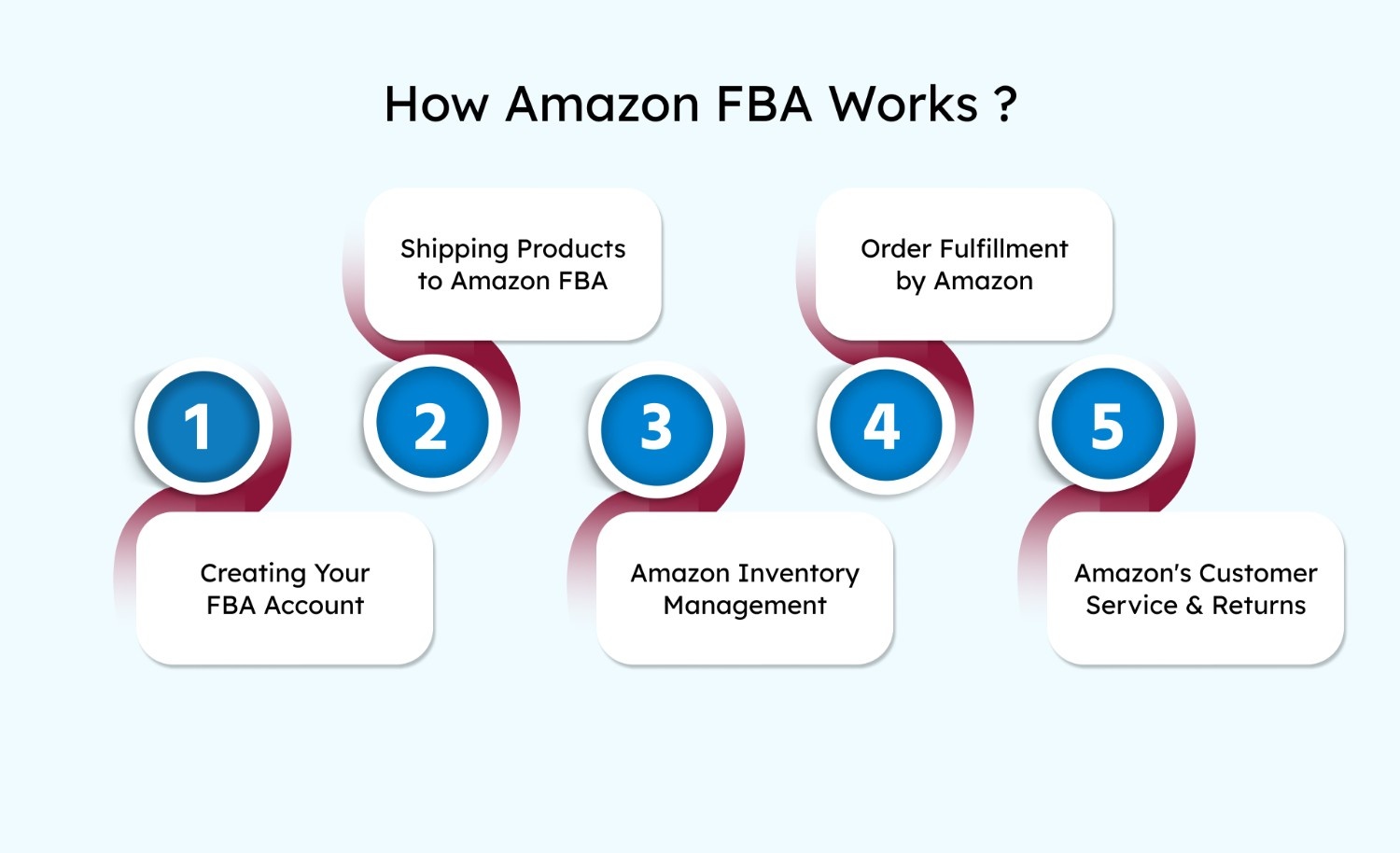
Amazon FBA streamlines e-commerce by automating fulfilment and customer service; however, success begins with understanding each stage of the process. Here’s a comprehensive look at how FBA operates:
1. Setting Up Your FBA Seller Account
To begin your FBA journey, properly establishing your seller account is the foundational first step. This ensures that you’re ready to list products, manage inventory, and start fulfilling orders through Amazon.
- Account Registration: Register on Seller Central using your ID, tax information, credit card details, phone number, and bank account information.
- Selling Plan: Choose between the Individual Plan (with no monthly fee, but per-item fees apply) or the Professional Plan (with a monthly payment, offering lower per-item fees).
- Business Verification: You may be required to provide additional documentation or participate in a video verification call to complete the process.
- Tax Compliance: Ensure to register for taxes in your selling region (e.g., GST, VAT).
2. Preparing and Shipping Your Products to Amazon Fulfilment Centres
Once your account is set up, the next step is to prepare and ship your products to Amazon’s fulfilment centres.
- Product Listing: List your products in Seller Central, including detailed descriptions, clear images, and relevant keywords to improve discoverability.
- Packaging and Labelling: Package your products securely by Amazon’s standards, ensuring fragile items receive sufficient protection. Label each unit with a scannable barcode, either the FNSKU or UPC.
- Shipment Plan: Create a shipment plan in Seller Central, specifying the products, quantities, and fulfilment centres where your inventory will be sent.
- Shipping Products: Ship your products using Amazon’s Partnered Carrier program for discounted rates, or select your preferred carrier and follow Amazon’s packing and routing guidelines.
3. Inventory Storage and Management by Amazon
Once your inventory arrives at Amazon’s fulfilment centres, it's crucial to track and manage it effectively. Amazon takes care of storing your products, but staying on top of your inventory will help you avoid stockouts and optimise your storage space.
- Receiving Inventory: Once your shipment arrives, Amazon scans and stores your products across multiple fulfilment centres to ensure fast delivery.
- Inventory Tracking: Utilise Seller Central to monitor your stock levels, incoming shipments, and reserved inventory in real-time.
- Inventory Health Reports: Analyse reports to identify slow-selling or stranded inventory that might require attention.
- Restocking Alerts: Set automated notifications to replenish stock before it runs low, avoiding storage fees and stockouts.
4. Order Processing, Picking, Packing, and Shipping
With your products ready in the fulfilment centres, Amazon handles the picking, packing, and shipping process. This efficient system ensures that your customers receive their orders quickly and accurately.
- Order Fulfilment: Amazon automatically selects the closest fulfilment centre with available stock when a customer places an order.
- Picking and Packing: Amazon staff select products from the shelves and pack them according to strict guidelines, including branded packaging for Prime orders.
- Shipping: Amazon ships orders through its logistics network, providing tracking information to both the seller and the customer. It often offers free one or two-day delivery.
- Multi-Channel Fulfilment: You can use your FBA inventory to fulfil orders from other sales platforms like Shopify or eBay.
5. Amazon’s Role in Customer Service and Returns Handling
Finally, Amazon’s customer service and returns management system ensures a seamless experience for both sellers and customers. This can save you time and effort, as Amazon handles most customer interactions on your behalf.
- Customer Support: Amazon handles all pre- and post-sale customer inquiries, including order status and shipping questions, and is available 24/7.
- Returns Management: Customers initiate returns through Amazon’s platform. Amazon inspects the returned items and determines whether they can be restocked or disposed of.
- Refunds and Reimbursements: Amazon processes refunds directly and reimburses sellers for lost or damaged inventory under FBA policies.
- Performance Monitoring: Sellers should track their seller ratings, customer feedback, and return reasons to identify potential improvements to their products or listings.
Pro Insight: Stay proactive by enabling two-factor authentication, monitoring inventory health, tracking customer feedback, and regularly reviewing return reasons to maintain compliance, optimise stock levels, and improve your product listings for better sales and seller ratings.
Navigating imports for FBA? Streamline your cross-border selling with WareOne’s Integrated Customs Clearance for hassle-free documentation and real-time updates.
Once you fully grasp the workflow, it's essential to understand the costs associated with FBA to manage profitability effectively.
Detailed Breakdown of Amazon FBA Fees and Costs
Understanding Amazon FBA’s fee structure is necessary for maintaining profitability and managing your business efficiently. Here’s a clear overview of the main fees you’ll encounter:
1. Fulfilment Fees: Coverage and Calculation
Amazon FBA fulfilment fees cover the costs of picking, packing, shipping, and handling customer service for each order fulfilled by Amazon. These fees are charged per unit and vary based on your product’s size and weight category: standard, oversized (large, bulky, extra-large), or requiring special handling.
Additionally, specific categories, such as hazardous materials or apparel, may have particular fee structures or additional compliance requirements; therefore, it’s vital to review Amazon’s guidelines for your product type to estimate costs accurately.
Below is a detailed table showing the current non-apparel, non-peak fulfilment fees for the primary size tiers.
2. Storage Fees: Monthly, Long-Term, and Seasonal Variations
Monthly storage fees are charged based on the cubic feet your inventory occupies in Amazon’s warehouses. Due to higher demand for space during peak holiday months (October through December), these fees tend to increase. Long-term storage fees apply to products stored for more than 181 days, which can increase costs if the inventory doesn’t sell promptly.
3. Additional Fees: Removal, Returns Processing, and Labelling Services
Beyond fulfilment and storage fees, Amazon FBA charges additional fees for specific services and situations. Understanding these helps you avoid unexpected costs and plan your operations better:
- Removal Fees: If you decide to have Amazon return or dispose of unsold or excess inventory, removal fees will apply.
- Returns Processing Fees: Certain product categories, like apparel and shoes, incur fees when customers return items.
- Label Service Fees: If you opt for Amazon to label your products with barcodes (FNSKU), you will be charged a per-unit fee for this service. This can save you time, but it may also increase costs.
4. Strategies to Minimise FBA Fees and Avoid Storage Penalties
Managing FBA fees effectively requires proactive strategies to minimise unnecessary costs and avoid storage penalties. By staying on top of inventory management and utilising available Amazon services, you can reduce fees and maintain profitability.
- Monitor inventory levels closely to avoid overstocking and minimise slow-moving or stranded inventory.
- Utilise promotions, discounts, or removal strategies to clear aged stock before long-term storage fees are applied.
- Consider utilising Amazon Warehousing and Distribution (AWD) services for bulk storage and automated replenishment to optimise logistics and inventory management.
With your costs under control, let’s focus on maximising your sales and taking full advantage of FBA’s growth potential.
Maximising Your Sales Potential with Amazon FBA
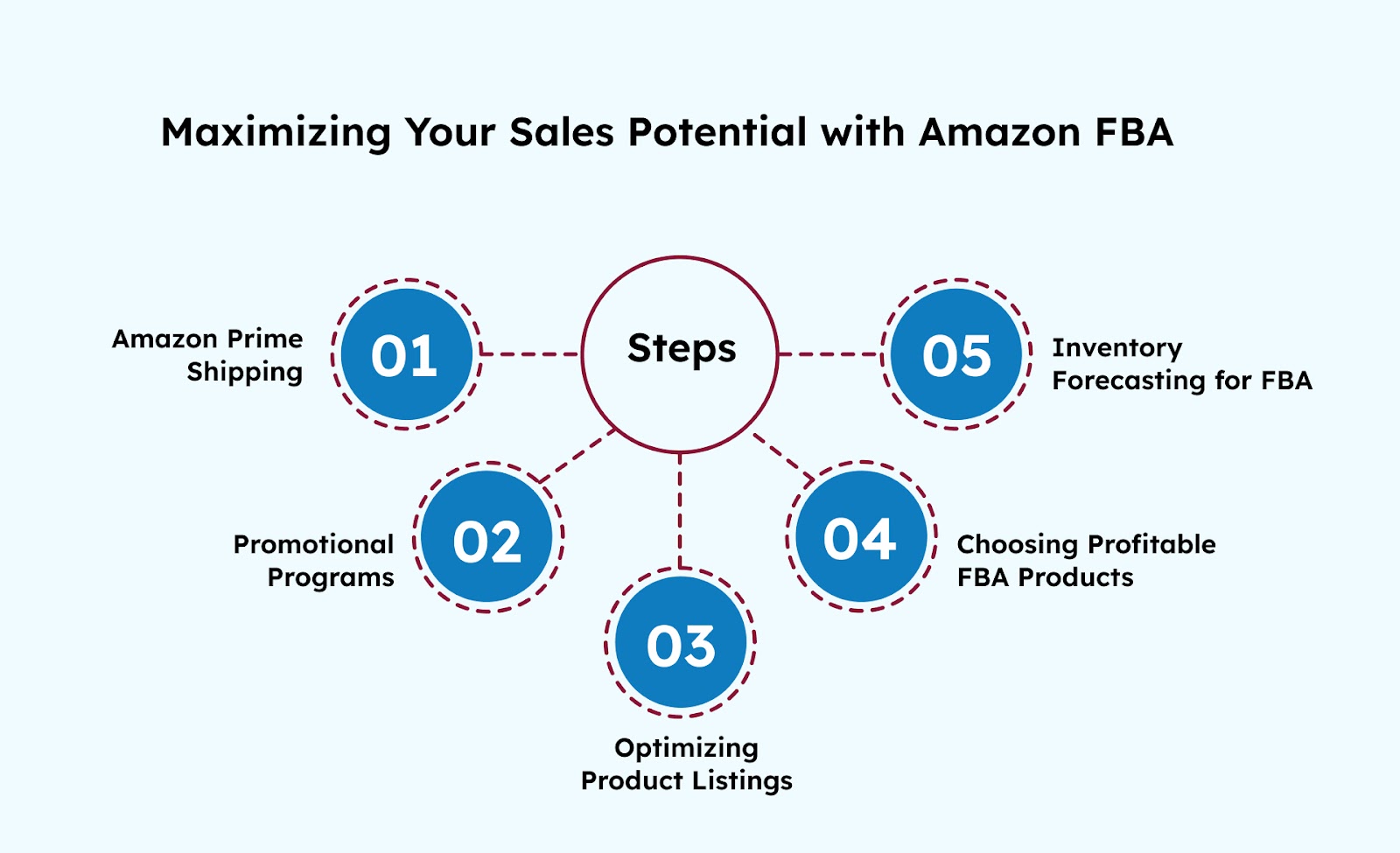
Besides being a fulfilment service, Amazon FBA is a sales platform that accelerates business growth. You can boost product visibility, increase conversions, and build customer loyalty by taking advantage of Amazon’s large customer base, Prime program, and marketing tools.
Success requires fast delivery, smart promotions, optimised listings, strategic product selection, and efficient inventory management. The following steps help you stand out and scale your business effectively.
1. Using Amazon Prime Eligibility and Fast Shipping
Products fulfilled through FBA automatically qualify for Amazon Prime, providing you with access to millions of loyal Prime customers who expect fast and reliable shipping. Prime eligibility increases your product’s appeal and conversion rates, as many shoppers filter results to show only Prime-eligible items.
2. Using Promotional Programs: Subscribe & Save, Lightning Deals, and Coupons
Amazon’s promotional tools help enhance product visibility and encourage repeat purchases. Programs like Subscribe & Save offer customers discounts on recurring orders, while Lightning Deals create a sense of urgency with limited-time offers. Coupons attract bargain hunters and help you efficiently move excess inventory, thereby improving overall sales velocity.
3. Optimising Product Listings for Better Visibility and Conversion
Strong product listings are key to attracting and converting shoppers. Use high-resolution images that showcase your product clearly from multiple angles. Craft compelling titles that include relevant keywords without keyword stuffing. Write detailed, benefit-focused descriptions that highlight features and solve customer pain points. Monitor and respond to customer reviews to build trust and demonstrate excellent customer service.
4. Selecting Profitable Products Suited for FBA Fulfilment
Select products with consistent demand and reasonable size and weight to minimise fulfilment costs. Calculate margins carefully by factoring in FBA fees, shipping, and advertising expenses. Avoid products with complex compliance requirements or high return rates. Focus on items where you can maintain competitive pricing while sustaining healthy profits.
5. Inventory Forecasting to Prevent Stockouts and Overstock Situations
Maintain balanced inventory levels using Amazon’s inventory management tools and forecasting dashboards. Avoid stockouts that lead to lost sales and hurt your seller metrics. Likewise, prevent overstocking to reduce storage fees and minimise the risk of inventory ageing. Regularly review sales trends and seasonality to adjust your purchasing and replenishment strategy effectively.
Adopting these sales strategies sets the stage for effective inventory management, operational control, and sustainable business growth.
Managing and Scaling Your FBA Business
Running a successful FBA business is about more than just selling. It’s about scaling smartly and maintaining operational excellence. In 2025, Amazon reported that sellers using FBA saw an average sales increase of 30% compared to those fulfilling orders themselves, highlighting the competitive edge that FBA provides.
1. Utilising Tools and Reports in Seller Central to Monitor Performance
Seller Central provides rich analytics and reports that offer valuable insights into sales trends, inventory health, customer feedback, and advertising performance. Regularly reviewing these reports enables you to make data-driven decisions, identify bestselling products, detect slow movers, and optimise pricing and promotions.
2. Efficient Inventory Health and Replenishment Management
Maintaining optimal inventory levels is crucial to avoid stockouts, which hurt sales, and overstocking, which incurs long-term storage fees. Use Amazon’s automated alerts and restocking recommendations to stay ahead. Utilise inventory performance dashboards to track sell-through rates and identify stranded inventory, enabling timely action.
3. Automating Repricing and Order Fulfilment Workflows
Competitive pricing is key to winning the Buy Box and increasing sales. Repricing tools can help you adjust prices dynamically based on market conditions, competitor prices, and inventory levels, reducing manual effort. Workflow automation for order processing and inventory updates also frees time and reduces errors, allowing you to focus on strategic growth activities.
4. Expanding into International Marketplaces via Amazon’s Global FBA Network
Amazon’s extensive global fulfilment infrastructure enables you to tap into new markets with minimal hassle. By enrolling in programs like FBA Export or using Amazon’s marketplaces in Europe, North America, and Asia, you can diversify your revenue streams and reduce dependence on a single market. Cross-border selling requires careful planning to address compliance, shipping costs, and localisation, but it also offers significant growth opportunities.
5. Maintaining Positive Seller Metrics and Customer Reviews
Seller performance metrics, such as order defect rate, late shipments, and cancellations, directly affect your account health and Buy Box eligibility. Promptly responding to customer inquiries and resolving issues helps keep high ratings and positive reviews. Providing a good service consistently lowers the risk of suspension or penalties.
Ready to scale efficiently beyond FBA's direct scope? Pair your FBA operations with WareOne’s Flexible Distribution Logistics to manage inbound stock, returns, and regional shipments across the GCC.
Despite implementing these best practices, FBA sellers still face challenges such as fluctuating demand, supply chain disruptions, and increasing competition. Let’s see how to address them effectively!
Common Challenges and How to Address Them
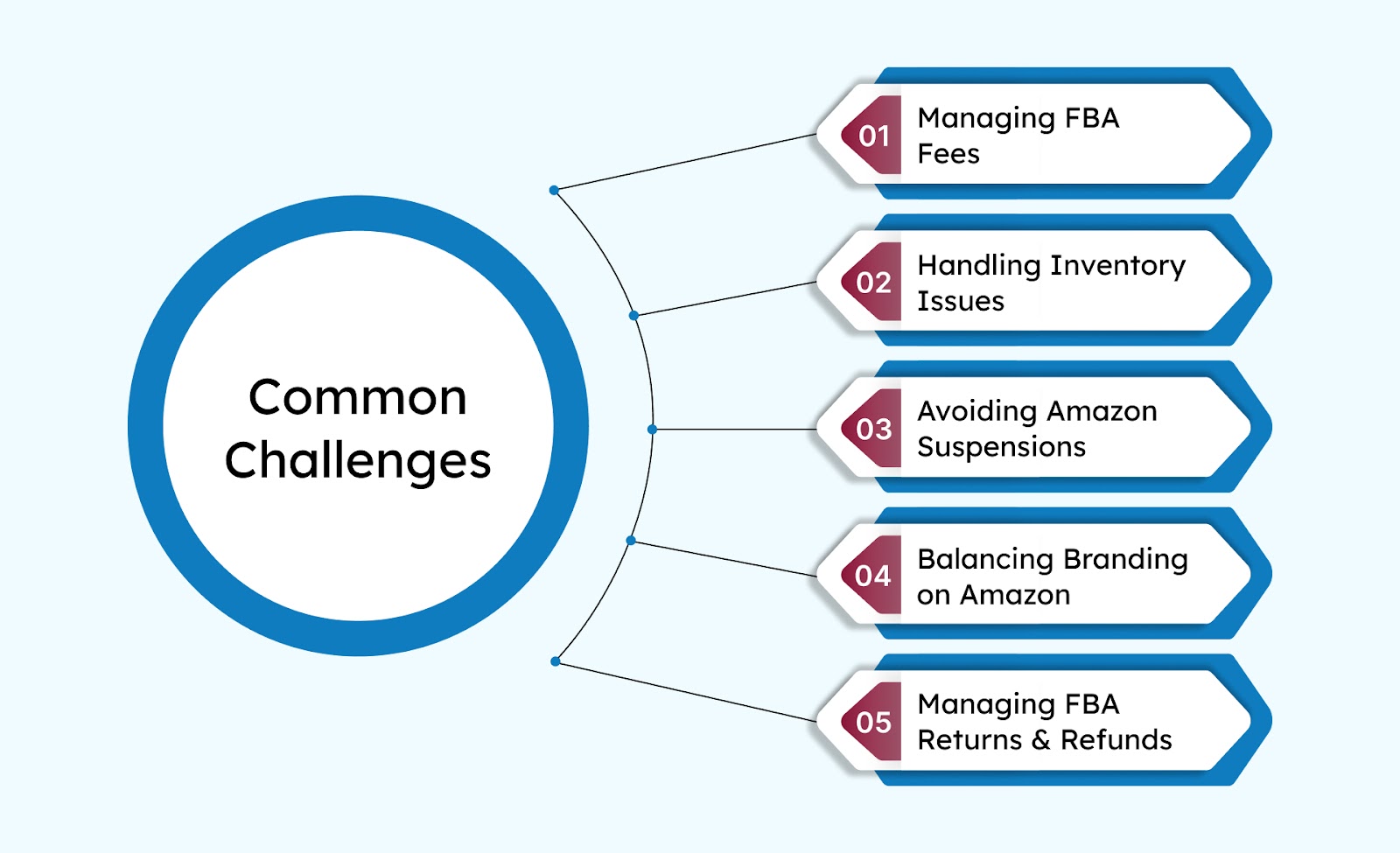
Running an Amazon FBA business comes with its share of challenges, but knowing what to expect helps you handle them more effectively. Here are key issues sellers face and practical ways to manage them:
1. Managing FBA Fees and Maintaining Profitability
FBA fees can add up quickly if not carefully managed. Regularly review your fee structure, including fulfilment, storage, and additional service fees. Focus on items with strong margins after fees to optimise your product selection and maximise profitability. Monitor inventory levels to avoid costly long-term storage charges and adjust pricing or promotions to protect profitability.
2. Dealing with Inventory Damage, Lost Stock, and Warehouse Delays
Inventory can be damaged or lost during transit or at fulfilment centres. Use Amazon’s inventory reconciliation reports to identify discrepancies early. File claims promptly for lost or damaged goods to recover costs. Maintain good communication with suppliers and closely monitor inbound shipments to minimise delays.
3. Complying with Amazon’s Strict Policies to Avoid Account Suspensions
Amazon enforces strict rules regarding product listings, customer service, and seller behaviour. Stay updated on policy changes, maintain accurate and compliant listings, and respond quickly to performance warnings or violations. Address issues proactively to prevent suspensions that can disrupt your business.
4. Branding Concerns: Balancing Amazon’s Control with Your Brand Identity
While Amazon controls much of the customer experience, you can strengthen your brand through enhanced brand content, custom storefronts, and branded packaging. Investing in these areas helps differentiate your products, build customer loyalty, and reduce price-based competition.
5. Handling Customer Returns and Refunds Through FBA
Returns are inevitable, especially in categories like apparel and electronics. Monitor return reasons to identify issues with product quality or descriptions and use this feedback to make improvements. Ensure quick and professional resolution of returns to maintain high customer satisfaction and positive seller feedback.
Struggling with FBA storage fees or slow-moving stock? WareOne’s Flexible Warehousing Solutions offers on-demand space. Our platform provides real-time visibility and seamless integration to manage inventory and shipping so that you can focus on growth.
Simplifying Your Amazon FBA Business with WareOne’s Solutions
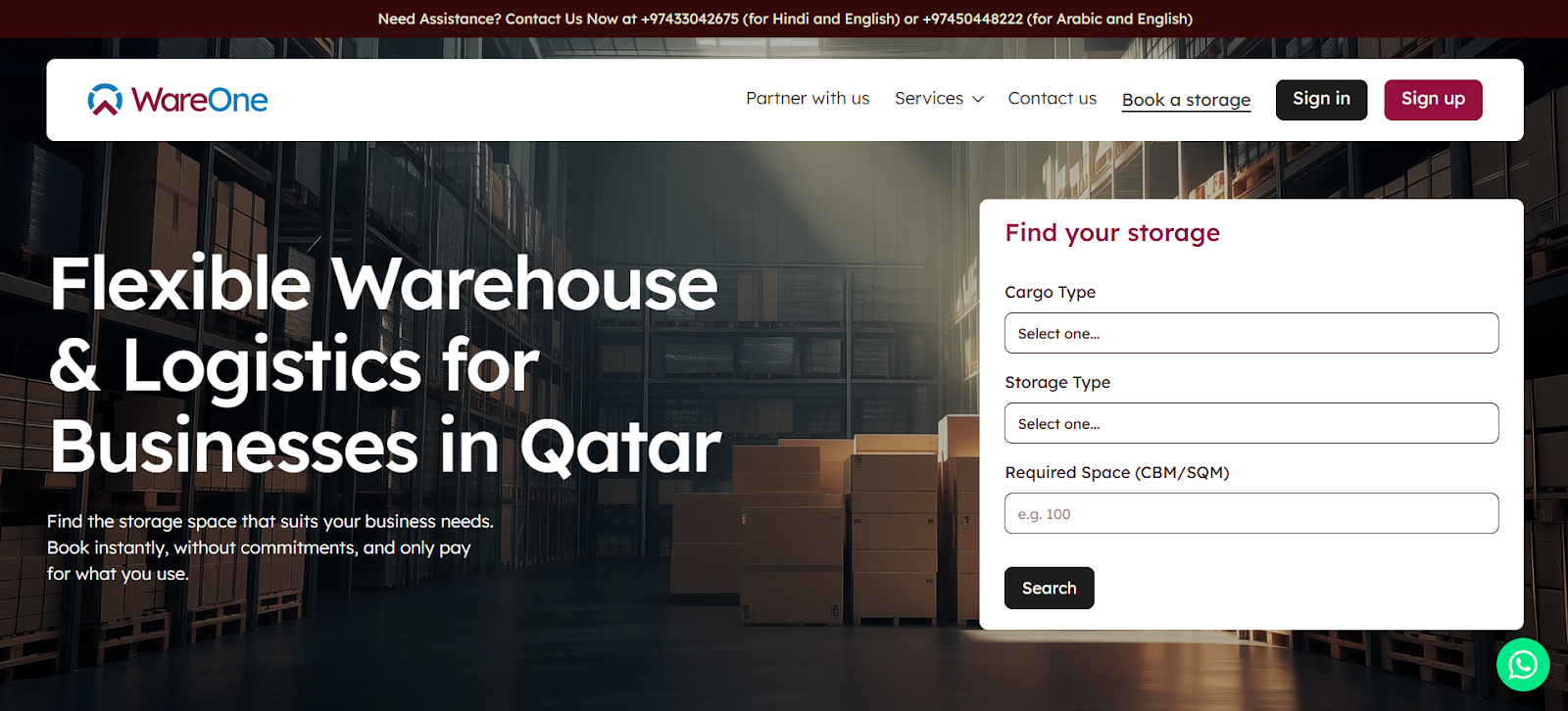
Starting with Amazon FBA involves multiple steps, from setting up accounts to managing shipping. At WareOne, we complement this by providing scalable warehousing and on-demand transportation solutions. Here’s how we make your FBA journey easier:
- Flexible Storage Options: Pay only for the space you need, with flexible terms that adapt to your inventory flow.
- On-Demand Transport Services: Easily manage deliveries and returns with no delays.
- Real-Time Tracking: Our intuitive platform monitors your stock and shipments from start to finish.
- Dynamic Pricing: Enjoy transparent, flexible pricing that aligns with your business needs.
- Customs & Compliance Support: We handle import documentation, smoothing cross-border logistics.
Need end-to-end support? Check out our full suite of WareOne E‑commerce Services, tailored to complement your FBA journey—no filler, just what matters.
Conclusion
Amazon FBA offers numerous benefits, including access to Amazon’s vast customer base, fast Prime shipping, and efficient logistics. This allows you to focus on growing your business while Amazon manages inventory, fulfilment, and customer service, enhancing buyer trust and convenience.
However, FBA also has limitations, such as fees that can impact your margins, strict policies requiring careful compliance, and less control over packaging and branding. Effective inventory management is crucial to prevent costly storage fees and stockouts.
Before enrolling, consider factors like your product type, sales volume, and profit margins. FBA is ideal for sellers looking to scale quickly or use Amazon’s global network. Smaller or niche sellers may benefit from starting with manual or hybrid fulfilment methods.
If you’re looking to enhance your warehousing, logistics, or supplier partnerships alongside Amazon FBA, Wareone offers a digital platform tailored to help you connect with reliable suppliers and optimise your supply chain. Whether you’re starting or scaling up, Wareone provides flexible and efficient solutions to build a future-ready business. Connect with us today!
.jpg)